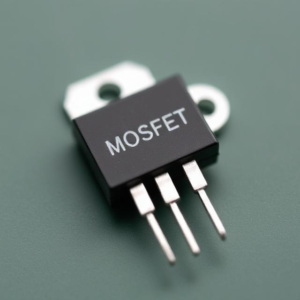A MOSFET (Metal-Oxide-Semiconductor Field-Effect Transistor) is a type of transistor, which is a basic electronic component used to control electrical signals in circuits. MOSFETs are widely used in electronic devices because they are efficient, small, and can switch on and off very quickly.
The key idea behind a MOSFET is that it can act like a switch or amplifier, controlling the flow of electrical current. A MOSFET is made up of three parts:
- Source: Where the electrical current enters the transistor.
- Drain: Where the current exits the transistor.
- Gate: A control terminal that regulates whether the MOSFET allows the current to flow between the source and the drain.
By applying a voltage to the Gate, you can control the flow of current between the source and the drain. If a voltage is applied to the Gate, it allows current to flow, and if there is no voltage, it blocks the current (like turning a switch on or off).

How Does a MOSFET Work?
A MOSFET works by creating an electric field using the voltage applied to the Gate. This electric field controls the flow of current between the Source and Drain.
- When there’s a voltage on the Gate, it “opens” a path for current to flow between the Source and Drain.
- If no voltage is applied to the Gate, the path is “closed,” and no current flows.
Think of it like a water faucet: the Gate is like the faucet handle, and the Source and Drain are like the pipes. Turning the handle (applying voltage to the Gate) allows water (electric current) to flow through the pipes (between the Source and Drain).
Types of MOSFETs
- N-channel MOSFET:
- This type of MOSFET allows current to flow when a positive voltage is applied to the Gate. It’s commonly used in many applications because it has better performance in terms of efficiency.
- P-channel MOSFET:
- This type allows current to flow when a negative voltage is applied to the Gate. P-channel MOSFETs are often used in combination with N-channel MOSFETs to create more efficient circuits.
Applications of MOSFETs
MOSFETs are widely used in various applications because they can handle both low and high-power circuits. Some common areas where MOSFETs are used include:
1. Switching Applications (Turning things on and off)
- Power Supply Circuits: MOSFETs are used to switch power on and off in devices like power adapters, battery chargers, and DC-DC converters. For instance, in a phone charger, the MOSFET helps regulate how power is supplied to the phone.
- LED Drivers: MOSFETs are used to control the brightness of LED lights by adjusting the power sent to the LEDs.
2. Amplification (Making Signals Stronger)
- Audio Amplifiers: MOSFETs are used in audio systems to amplify the weak audio signals from your device into a stronger signal that can drive speakers.
- Signal Processing: In applications like radio receivers, TVs, and cell phones, MOSFETs amplify weak signals (such as sound or radio waves) to a usable level.
3. Digital Circuits (Controlling Logic)
- Microprocessors: MOSFETs are the building blocks of microprocessors used in computers, phones, and other devices. These microprocessors are made up of millions (or even billions) of MOSFETs that perform complex calculations and logic operations.
- Memory Devices: MOSFETs are used in memory storage components like RAM (Random Access Memory) and Flash Memory because they can efficiently store and retrieve data.
4. Motor Control (Controlling Electric Motors)
- Electric Motors: MOSFETs are used to control the speed and direction of electric motors in devices like fans, electric vehicles, and robots. For example, in an electric car, MOSFETs control the motor’s speed and help make the car more energy-efficient.
- Servo Motors: In robotics, MOSFETs are used to control the positioning of servo motors that move robotic arms or other parts.
5. Power Electronics (Efficient Power Management)
- Solar Power Systems: In solar energy systems, MOSFETs are used to regulate the power from solar panels to charge batteries or supply electricity to a home or building.
- Inverters: Inverters, which convert DC (Direct Current) power to AC (Alternating Current) power (like in solar systems), often use MOSFETs to switch and manage the current flow.
6. Signal Modulation and Communication
- RF Amplifiers: In radio frequency (RF) applications, like mobile phones, Wi-Fi routers, and radios, MOSFETs help amplify signals to ensure clear and stable communication.
- Switching Circuits: MOSFETs are also used in communication systems to modulate signals and manage data transmission in devices like satellite transmitters, GPS, and Wi-Fi.
7. Consumer Electronics (Smart Devices and Gadgets)
- Smartphones and Tablets: MOSFETs are used in smartphones and tablets to control the power supply to different components like screens, processors, and cameras, helping to extend battery life.
- TVs and Monitors: In devices like LED TVs or LCD monitors, MOSFETs are used to control power and improve image quality.
Why Are MOSFETs So Popular?
- Efficiency: MOSFETs are highly efficient because they have very low power loss when they are in the “on” state. This makes them ideal for power-sensitive applications like mobile devices and electric cars.
- Fast Switching: MOSFETs can switch on and off very quickly, which is important for modern digital circuits and high-frequency applications like radio communication.
- Compact Size: Because MOSFETs are very small, they can be used in a wide variety of applications without taking up much space. This is why they are used in everything from tiny gadgets to large power systems.
- Cost-Effective: MOSFETs are relatively inexpensive to manufacture, making them a popular choice for both consumer electronics and industrial applications.











